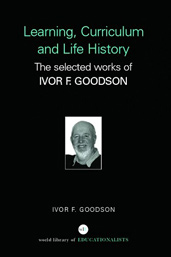Learning, Curriculum and Life Politics: the selected works of Ivor F. Goodson
Long Waves of Educational Reform
These early experiments lasted for the first years, but by September 1973, Durant had moved into a former college building with classrooms for all the staff. However, the goal of developing independent learners connected to the community at large remained paramount, and the staff encouraged students to take classes at local colleges and pursue independent studies and community internships under teacher supervision. In this sense, in many ways, the school still therefore existed ‘without walls’, and the 1970s saw much of the original innovative spirit carried forward. The 1970s was a stable period, with David Henry working to keep the School’s unique goals at the forefront of staff meetings and school discussions, Durant’s mission permeated the day-to-day life of the school.
Sheldon School moved into a new building in 1959. Whilst it enjoyed a period as the ‘Jewel in the Crown’ of the district, it certainly did not in any way challenge the grammar of schooling in the same way as Durant. Because Sheldon was a neighborhood school, it had a strong feeder pattern – if you lived in the neighborhood you went to the high school in that area. The feeder pattern helped to instill a sense of pride for one’s school both among teachers and among students. According to one teacher, “the feeder pattern developed a feeling towards the school of an attraction, connectivity if you will. You know, ‘I went to that school, my old man went to that school.’ A lot of families, a lot of children who went here [Sheldon], their parents went here. And that’s good. There was a feeling, a sense of pride.” As a result of the new facility and the comprehensive school set-up, Sheldon became known as the best school in the district. Another teacher recalled being interviewed by the Bradford City School District in the late 1960s and being told by the citywide director of English to ‘Go to Sheldon, it’s the best!’ Sheldon was a school that was known to have many high academic achievers and subsequently became a school with a great pride in its academic reputation.
The newness of the building, and the development of new activities and curriculum to fit this new milieu, gave Sheldon a fresh and innovative feel, even though its academic program was more conventional than Durant’s. In both schools, however, the sense of innovation and change began to ebb in the seventies, first at Sheldon, where racial strife began to break out, and later at Durant, where in 1981 it was re-designated as a magnet school. In both cases, changes in the matrix of schooling in Bradford and in overall broad policy began to transform the missions of the two schools.
In the case, particularly of Durant, it began to regress towards a more conventional school with less external control over its clientele or its goals. One is reminded of Tyack and Tobin’s epitaph for the attempts to define alternatives to traditional schools in the period of the late 60’s and 70’s: “a bold yet fragile challenge to the grammar of schooling, the rebellion of the 1960s and early 1970s ebbed. Policy talk on flexible scheduling rose and fell rapidly. The experiment left behind here and there some new forms of flexibility, but the older institutional patterns were still dominant” (Tyack & Tobin 1994, pp. 475-476).
